Disclosure: this Kawai GL-10 Review was written by a Kawai dealer. Still, the opinions are genuine and come from a team of piano lovers with diverse musical backgrounds.
Background of Kawai GL Series
Kawai is a renowned Japanese piano manufacturer known for their high-quality acoustic and digital pianos. Since 1927, they’ve focused on combining traditional craftsmanship with modern technology to create exciting instruments.
The company’s commitment to excellence has earned it many awards, including MMR’s 2016 “Product of the Year” award for its GL Series grand pianos. This was the first and only time an acoustic piano line ever won the award, and Kawai recently took home “Acoustic Piano Line of the Year” in 2022 too!

Kawai GL Series Grands won MMR’s "Product of the Year" award in 2016, and Kawai just won “Acoustic Piano Line of the Year” in 2022 too! They've won received over 55 major international awards for excellence -- no small feat!
“Kawai is once again [for the 5th time] in the winner’s circle as “Acoustic Piano Line of the Year” and, given the variety of excellent instruments available and the brand’s stellar reputation, that isn’t particularly surprising. Over nine decades of innovation have made this Japanese brand the go-to line for professionals, hobbyist players, and institutions the world over.” –MMR Magazine on Kawai, 2022
The GL Series represents professional quality made available to everyday people. GL Grands set out to be pianos that aren’t just good for the money, but good period. Even compared to their previously best-selling GM Series grand pianos, Kawai managed to continue improving their build quality in the GL line, adding lengthened keysticks and a tapered soundboard for starters.
The GL-10 is the entry-level piano to this prestigious line. It’s a baby grand measuring 5’0” in length, a size perfect for pianists who want a grand at home but have limited space. It’s recognized for its impressive sound and high-quality construction, and it’s suitable for all kinds of players regardless of level or style.
Since its release in 2015, the GL-10 has been a constant favorite among pianists. With its current MAP of $16,295, it’s set at a very competitive price point for a new major-brand grand piano, and it’s generally considered to be one of the best baby grands available today.
The Design: A Sophisticated Baby Grand Piano
The Kawai GL-10 baby grand piano has a sleek and modern design. You can’t exactly claim the cabinet to be ground-breaking – it looks like a grand piano typically does – but it does have that timeless and elegant look.
One thing we appreciate is that It comes available in various finishes, ensuring that you can find a fitting match for your home or performance space. The Ebony Polish finish is most popular among buyers since a shiny black grand is just classic, but we’re fans of the French Mahogany Polish ourselves too.
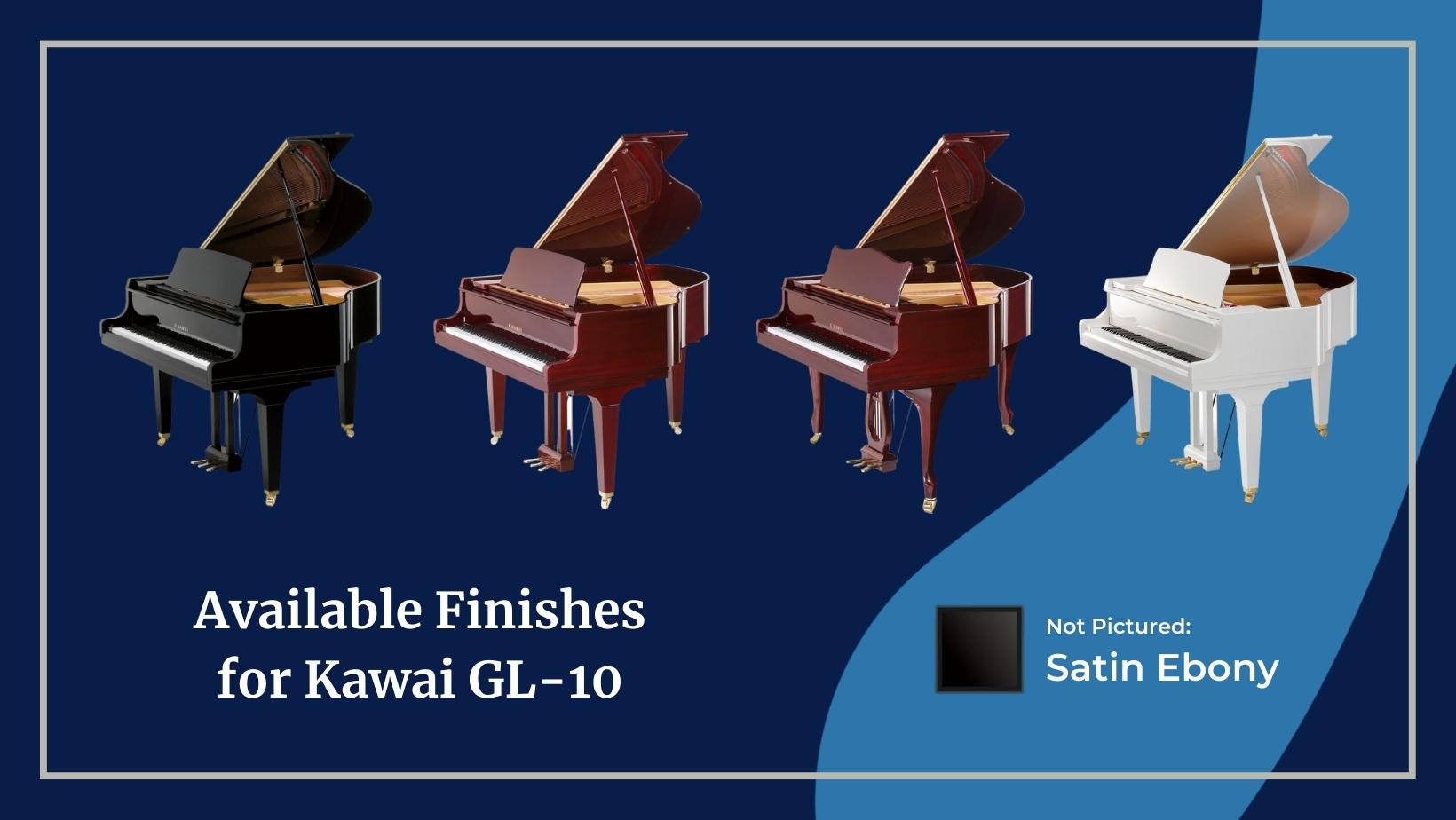
You can buy a Kawai GL-10 in (left to right): Polished Ebony, Polished Mahogany, French Polished Mahogany and Snow White -- as well as Satin Ebony which isn't pictured.
Of course, how it looks on the outside is only one element of the piano’s design. And the GL-10’s beauty isn’t just surface-level! It’s also been meticulously crafted on the inside, resulting in a durable high-quality instrument you can rely on.
Kawai spared no expense designing the GL-10. Its spec sheet resembles that of pianos at least twice its price, and it has several top-end features, such as:
- Solid Spruce Precision Tapered Soundboard
- Steel-Reinforced Keyslip and Keybed
- V-Pro Plate – Gray Iron with “Crossbone” Design
- Stretcher Over-Lap Integrated Design (SOLID) – Double-Width Stretcher Bar
- Multi-Grip 11-Ply Laminated Pin Block
- Solid Brass Agraffes
- Adjustable Music Rack & Lid Props, and
- Smooth-Rolling Casters
- Ultra-Slow “Soft Fall” Fallboard Closing System
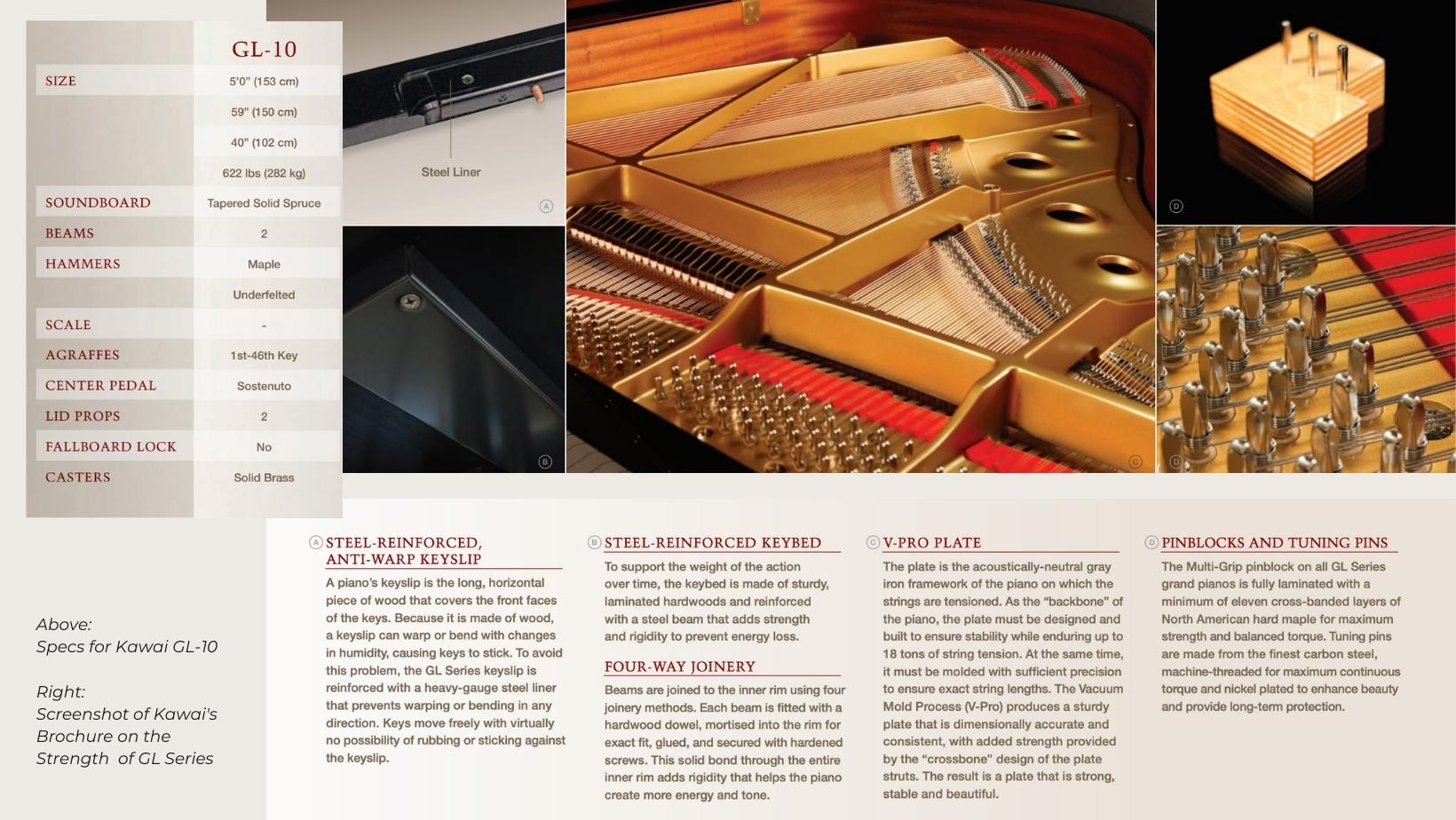
Kawai GL Grands were designed to deliver touch and tone that lasts. The GL-10 follows suit, boasting tons of engineering choices that result in a fortified piano. No need to worry about if it'll last -- this is a piano you can rely on for life!
On the whole, the Kawai GL-10 is simply a classic-looking over-engineered piano that anyone would want in their home (and that many can fit in their home). It manages to incorporate high-end design elements without also attaching a high-end sticker price. Players at home will enjoy all the consumer-friendly features – and our technicians certainly appreciate how easy it is to work on and tune too.
For the complete list of specs, check out the brochure for the entire Kawai GL Series.
The Feel: Millennium III Action Rocks
One other factor in the GL-10s design is Kawai’s decision to use their renowned Millennium III action. It’s otherwise unheard of for entry-level pianos to get a brand’s high-end action, but Kawai has ensured that the GL-10’s action is as impressive as the rest of its design.
The MIllennium III action is most famously known for featuring ABS-Styran and Carbon Fiber parts. This is a departure from the traditional all-wood mechanisms typically found in acoustic pianos, and it has been found to improve stability and precision over time.

The Kawai Millennium III grand piano action features ABS-Carbon materials to give you more power, better control and greater stability compared to a traditional wooden action.
The real kicker though is that Kawai uses the Millennium III action in all GL, GX, and Shigeru Kawai pianos. In other words, this $16,295 piano has the same fundamental mechanism used in the $200,995 Kawai SK-EX concert grand.
The Millennium III action has been widely praised by the industry for its fast repetition and great control, especially in lower dynamic ranges. These benefits are evident right out of the box on the GL-10, and it’s a joy to play for pianists of all skill levels.
While feel and experience is subjective, we’d say the GL-10’s action has a nice medium weight. You get a smooth and balanced playing experience throughout the whole range of the keyboard with unexpected responsiveness and sensitivity for a piano its size. In fact, we encourage anyone to try playing as softly as possible too; we find pianists find that easier on Kawai pianos with the Millennium III than on other comparable pianos.
It’s also worth mentioning that the action is easy to maintain, and over time, it should cost less to do so. It’s easy for technicians to pull it out and swiftly service any issues, and our techs find themselves doing less regulation on Kawai pianos compared to other brands. It does makes sense that techs are paid attention to in the piano’s design process since Kawai was founded by a technician!
Near the end of the video, Brendan shows off how easy it is to pull out the action in our Kawai GL-10 unboxing! Not that we recommend you try it at home. . . .
With the Millennium III action, the Kawai GL-10 sets the standard for entry-level grand pianos and delivers an exceptional playing experience. While baby grand pianos are typically condemned for their shorter keysticks, and yes larger grands certainly will offer more nuance, the GL-10 is capable of a level of expression that’ll impress even critical pianists.
The Sound: A Rich & Versatile Tone
Sound is one of the most difficult and subjective things to describe. But basically, the Kawai GL-10 does have a lot to offer when it comes to tone. We like it, and we think most people would too.
Recordings are never perfectly accurate, but we hope our three demos linked below convey a general sense of the sound!
In words, we’d describe the GL-10’s tone as slightly warm and very versatile. It’s lush and broad, and the sound lends itself well to a variety of genres. This piano has a cozy and homey kind of characteristic, as funny a description as that is.
The sound quality is further enhanced by the piano’s design and construction. You have a high-quality piece of spruce for the soundboard, underfelted hammers, and a thick and dense hardwood rim with the stretcher bar to maximize cabinet resonance.
These features work together to produce a sound that’s bigger than the GL-10’s size would suggest. Similarly, its sustain is particularly exceptional for a 5’0 piano under $20,000.
Of course, it is worth mentioning that all baby grand pianos have a ceiling in terms of possible sound quality. We think the GL-10 does well in spite of physical limitations, particularly in the midrange. But discerning players who could make a little more space would benefit from upgrading to the 5’2 GL-20 to get a more booming bass and more bell-like trebles. Moreover, Kawai’s GX Series Performance Grand Pianos start with the 5’5 GX-1, and that size is more suitable for the kind of pianists who want to accomplish professional recordings at home.
Overall, the Kawai GL-10 delivers a pretty full-bodied and resonant sound with a clear consistent tone. We think the Kawai tone is one that all types of pianists can enjoy. For the size and money, you’re hard-pressed to find a piano that’s much better, and it’s even hard to imagine getting much more out of a baby grand piano designed for homes.
Kawai GL10 vs Yamaha GB1K
In the piano world, Kawai and Yamaha are basically like Coke and Pepsi. Their instruments compete directly, and they actually have a shared history which further invites competition.
Yamaha’s GB1K is the comparable entry-level baby grand that faces off against the Kawai GL-10. You’ll find these two compared against each other more than any other two baby grand pianos, especially since they retail for around the same price and they’re pretty similar in specs.

As noted, the Kawai is slightly bigger than the Yamaha GB1K on all fronts. A few centimeters alone wouldn't make a huge difference, but it could be contributing a tad to the differences in tonal dynamics between the two pianos.
Both pianos are listed at the same length of approximately 5’0, both pianos feature high-quality spruce soundboards, and both pianos have actions that are made in Japan and assembled in Indonesia. There’s no doubt that both pianos are high-quality instruments!
In terms of the cabinet, the Kawai GL-10 is slightly heavier and a couple centimeters longer. Pianists who like to play sheet music often will notably miss the adjustable desk on the Yamaha GB1K, a feature only found on the Kawai GL-10.
Feel-wise, the Kawai has its Millennium III ABS Styran action while the Yamaha has a traditional wooden action. The Yamaha GB1K’s action is often described as being a bit heavier than the Kawai GL-10. Some may prefer that feeling over the Kawai’s. We do think the repetition on the Kawai should feel tighter to most, but we’ll have to test that to make any empirical claims.
Sound-wise, Yamaha is usually found to be fairly bright while the Kawai is mellower in tone. Yamaha’s bass and clarity are often praised too, but the Kawai GL-10 is nothing to sneeze at in these areas. Some players find the Yamaha GB1K to get a bit brash at louder volumes, something that we don’t find true of the GL-10, possibly due to its slightly larger size.
Overall, these pianos are quite similar, and again, we think anyone could be happy with either one. If you have a particular preference for tone or feel, that’ll make the decision easier. To us, the action is the main distinguishing factor to mind. You can manipulate a piano’s tone easier than you can its feel, and we think Kawai’s action is more rewarding and durable than most other pianos around this size.
Worth Upgrading to the Kawai GL20?
If you’re considering a Kawai GL-10, you might be thinking about jumping up to the 5’2 Kawai GL-20. It isn’t a lot more money relatively (an additional $2,700 based on 2023 MAP and EP finishes), but understandably, you might find it questionable just how much difference two inches can make.
Well, the GL-20 does indeed have a more focused tone, especially in the bass notes. The GL-20’s treble is even cleaner and crisper but – as is the case in the GL-10 – not as thick as its midrange. In a side-by-side comparison, the GL-10’s tone comes off less full overall, and the GL-20 is capable of better projection.
The improved sound is partly due to the bigger soundboard and longer strings, but the GL-20 also features Full Duplex Scaling and an additional beam on the soundboard.
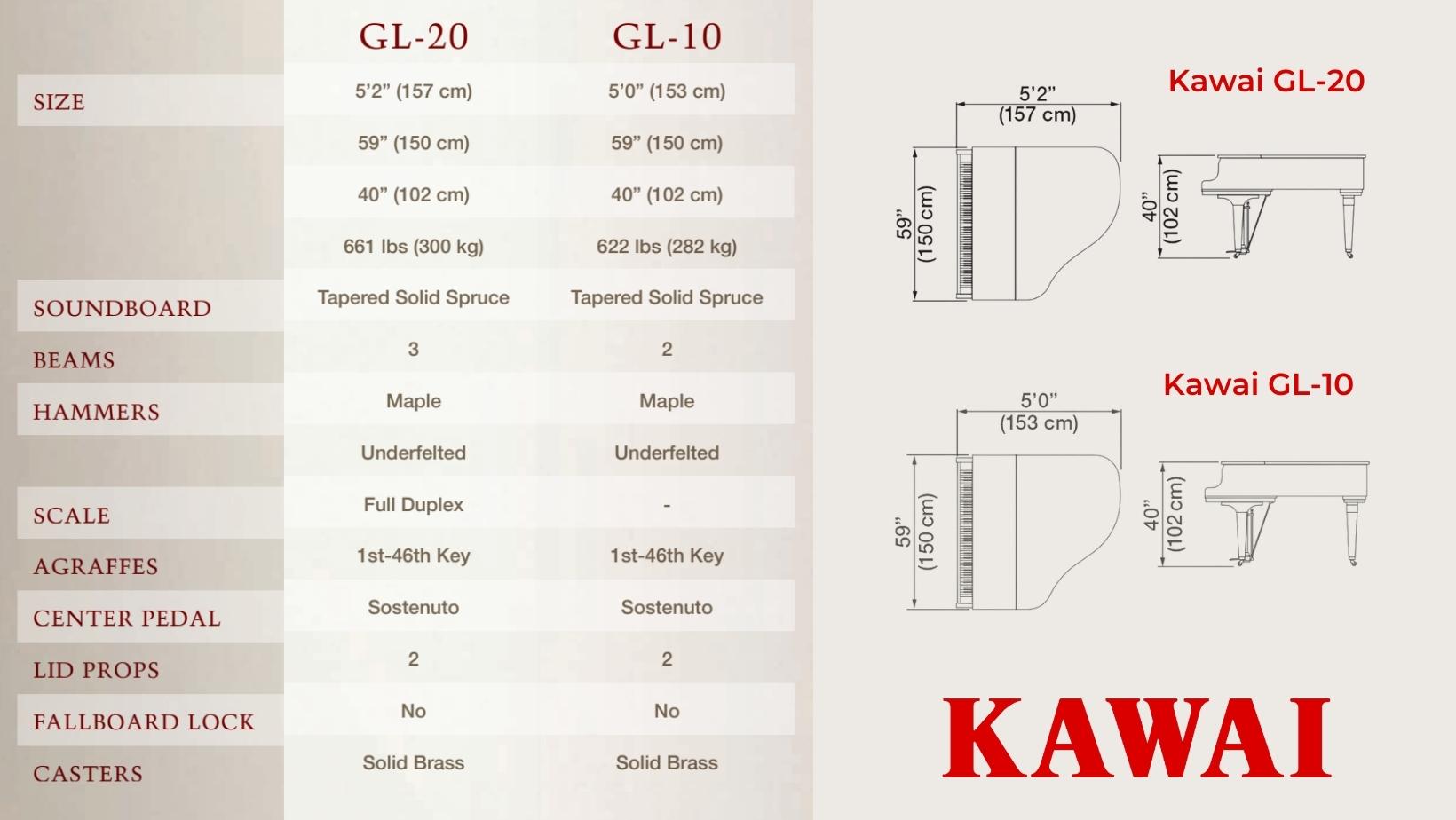
Looking at the spec sheet, you really wouldn't think these two grands are much difference. We definitely encourage you to play the GL-20 if you're thinking about the GL-10 though!
It’s worth noting that both models do have most of the same advanced GL Series features. Both are highly regarded by musicians and industry professionals. And furthermore, both the GL-10 and GL-20 are now built in Kawai’s Karawan factory in Indonesia so construction quality will be similarly high and consistent.
“The Karawan plant was designed to replicate perfectly the philosophy, culture and technologies of the famed Ryuyo Factory. Because these attributes of fine craftsmanship have been successfully reproduced at Karawan, the Kawai GL-10 and GL-20 have become two of the best-selling grand pianos in the world. (Note: GL-20 grands were produced at the Ryuyo Factory in Japan until the spring of 2019.)”
Ultimately though, choosing between the two for your home will come down to personal needs and any space or budget constraints. The GL-20 provides maximum performance with a minimum footprint for not a ton more money. That doesn’t take anything away from how good the GL-10 is though, and you can be happy knowing you’re putting a fantastic piano in your home either way.
You can also consider upgrading the GL-10 to include the AnyTime Silent System or a PianoDisc Player System!
The Verdict: Kawai GL10 is Top 3 Baby Grands
In our humble opinion, the Kawai GL-10 is a top 3 baby grand piano. And it probably isn’t 3, and it might not be 2 depending on individual preferences. . . .
Levity aside, it is undoubtedly one of the best baby grands on the market today.
Its durable design, fantastic feel and lush sound make it a popular choice among players looking for the best piano they can fit in their homes. It offers many features typically found on bigger, more expensive grands, plus its range of finishes and technology options lets you customize it into a piano you’ll always love.
With a MAP of $16,295, it really offers an exceptional value compared to pianos like the $65,000+ Steinway Model S Baby Grand. And even within the comparable under-$20,000 models, it’s generally one of the most preferred pianos among pianists and dealers alike.
If you are in the market for a baby grand piano, we highly recommend trying out the GL-10 for yourself to truly experience its sound and feel. We’re pretty confident anyone will be able to see why it’s won so many product of the year awards, and why we’re just as excited to show it to our customers today as we were when the first one arrived in our showroom 7 years ago.
Want to visit our showroom to try or buy a Kawai GL-10? Click to see it in our online shop!


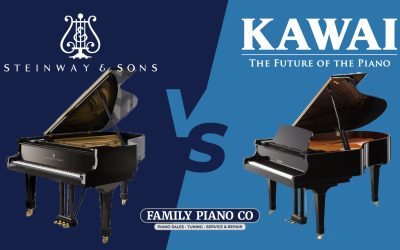
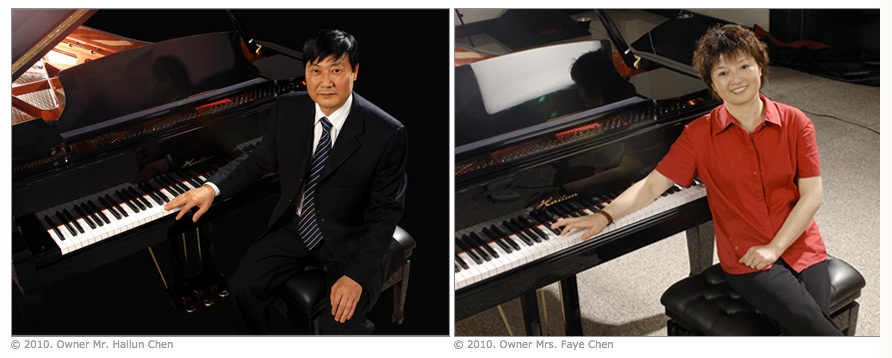
0 Comments